
Fortified wine is a wine to which a distilled spirit, usually brandy, has been added. In the course of some centuries, winemakers have developed many different styles of fortified wine, including port, sherry, madeira, Marsala, Commandaria wine, and the aromatised wine vermouth.
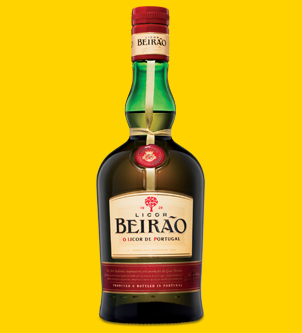
A liqueur is an alcoholic drink composed of spirits and additional flavorings such as sugar, fruits, herbs, and spices. Often served with or after dessert, they are typically heavily sweetened and un-aged beyond a resting period during production, when necessary, for their flavors to mingle.
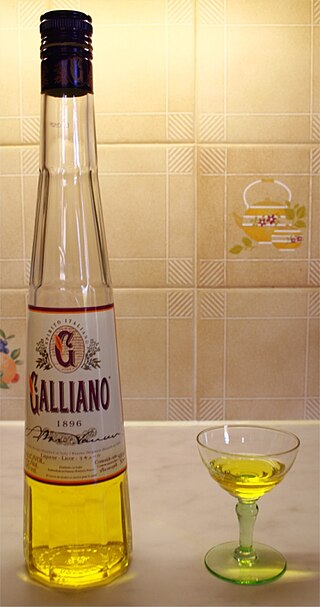
Liquore Galliano L'Autentico, known more commonly as Galliano, is a brand of sweet herbal liqueur produced in Italy. It was created in 1896 by Tuscan distiller and brandy producer Arturo Vaccari and named after Giuseppe Galliano, an Italian officer of the Royal Italian Army of the First Italo-Ethiopian War.
Schnapps or schnaps is a type of alcoholic beverage that may take several forms, including distilled fruit brandies, herbal liqueurs, infusions, and "flavored liqueurs" made by adding fruit syrups, spices, or artificial flavorings to neutral grain spirits.

A bitters is traditionally an alcoholic preparation flavored with botanical matter for a bitter or bittersweet flavor. Originally, numerous longstanding brands of bitters were developed as patent medicines, but now are sold as digestifs, sometimes with herbal properties, and as cocktail flavorings.
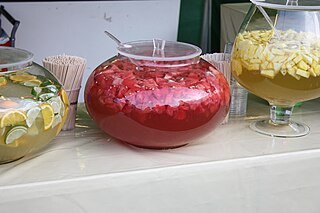
The term punch refers to a wide assortment of drinks, both non-alcoholic and alcoholic, generally containing fruits or fruit juice. The drink was introduced from the Indian subcontinent to England by employees of the East India Company in the late 17th century. Punch is usually served at parties in large, wide bowls, known as punch bowls.

Amaretto is a sweet Italian liqueur originating from the comune (municipality) of Saronno. Depending on the brand, it may be made from apricot kernels, bitter almonds, peach stones, or almonds, all of which are natural sources of the benzaldehyde that provides the almond-like flavour of the liqueur. It generally contains 21 to 28 percent alcohol by volume.

Aguardente (Portuguese), or aguardiente (Spanish), is a type of distilled alcoholic spirit that contains between 29% and 60% alcohol by volume (ABV). It is a somewhat generic term that can refer to liquors made from various foods. It originates from and is typically consumed on the Iberian Peninsula and in Iberian America.
Limoncello is an Italian lemon liqueur mainly produced in southern Italy, especially in the region around the Gulf of Naples, the Amalfi Coast, and Sicily. It is the second-most popular liqueur in Italy and is traditionally served chilled as an after-dinner digestif. It is also a popular homemade liqueur, with various recipes available online and in print.
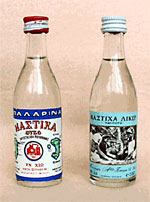
Mastika or mastiha is a liqueur seasoned with mastic, a resin with a slightly pine or cedar-like flavor gathered from the mastic tree, a small evergreen tree native to the Mediterranean region. In Greece, mastiha or mastichato is a sweet liqueur produced with the mastika resin from the Greek island of Chios, which is distilled after hardening to crystals. Sugar is typically added. It is a sweet liqueur that is typically consumed at the end of a meal. It has a distinctive flavor, reminiscent of pine and herbs. It is claimed to have medicinal properties and to aid digestion.
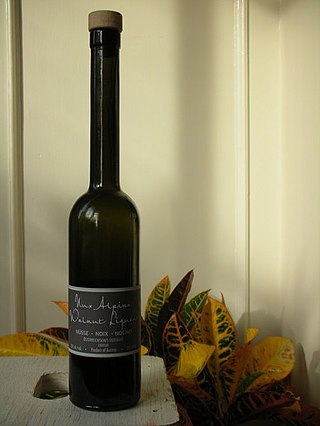
Nocino is a dark brown liqueur from the Emilia-Romagna region of Italy. It is made from unripe green walnuts. The walnuts and the liquor are handled using ceramic or wooden tools and placed in an alcoholic base. After steeping in spirit, the walnuts are removed and the alcohol is mixed with simple syrup. Nocino has an aromatic but bittersweet flavor. It may be homemade; villages and even individual families often have their own recipes, including different additions like cinnamon, juniper berries, lemon or orange zest, vanilla pods, coffee beans, or clove. The spices are added lightly, to avoid overpowering the flavour of the walnuts. A classic base consists of vodka. Nocino is also available commercially in bottled form. Commercially available nocino is typically 40 percent alcohol by volume, or 80 proof.
Flavored liquors are liquors that have added flavoring and, in some cases, a small amount of added sugar. They are distinct from liqueurs in that liqueurs have a high sugar content and may also contain glycerine.

The Fine Art of Mixing Drinks is a book about cocktails by David A. Embury, first published in 1948. The book is noteworthy for its witty, highly opinionated and conversational tone, as well as its categorization of cocktails into two main types: aromatic and sour; its categorization of ingredients into three categories: the base, modifying agents, and special flavorings and coloring agents; and its 1:2:8 ratio for sour type cocktails.
Drink mixers are the non-alcoholic ingredients in mixed drinks and cocktails. Mixers dilute the drink, lowering the alcohol by volume in the drink. They change, enhance, or add new flavors to a drink. They may make the drink sweeter, more sour, or more savory. Some mixers change the texture or consistency of the drink, making it thicker or more watery. Drink mixers may also be used strictly for decorative purposes by changing the color or appearance of the drink. They also simply increase the volume of a drink, to make it last longer.

Pallini Limoncello is a brand of traditional Italian Limoncello.

The old-fashioned doughnut is a term used for a variety of cake doughnut prepared in the shape of a ring with a cracked surface and tapered edges around it. While many early cookbooks included recipes for "old-fashioned donuts" that were made with yeast, the distinctive cake doughnuts sold in doughnut shops are made with chemical leavener and may have crisper texture compared to other styles of cake doughnuts. The cracked surface is usually glazed or coated with sugar.












